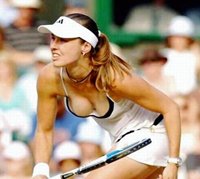5A176864-4AD8-43AD-B9AA-AEBADCB3D2F6
By Richard Pagliaro
Photo Credit: Andy Jacobs
(June 11, 2010) Martina Hingis made history at the age of 16 years, 6 months when she became the youngest player to reach the world No. 1 ranking. Now, the 29-year-old Hingis appears ready to write a comeback chapter to her career story.
She is one of only six women to hold the World No. 1 ranking in singles and doubles simultaneously and Hingis may be aiming for a full-fledged return to the WTA Tour — as doubles specialist.
Hingis will play a complete World TeamTennis schedule next month in what may well be a prelude to a return to the WTA Tour.
Hall of Famer and WTT founder Billie Jean King told the AP Hingis is "testing the waters" for a return to the WTA Tour after serving a two-year ban from the pro circuit following a positive test for cocaine at the 2007 Wimbledon.
In what could be another sign she is considering a comeback, Hingis will partner with Anna Kournikova at this month's Wimbledon Ladies Invitation, an exhibition event during The Championships.

Hingis is certainly young enough to launch a comeback and may be inspired by the successful returns of former World No. 1 players Kim Clijsters and Justine Henin in recent months. Another Hingis contemporary, Lindsay Davenport, announced she will play doubles with Liezel Huber in San Diego next month.
It would not be the first time Hingis used World TeamTennis as a test run for a return. She earned WTT Player Of The Year Honors in 2005 in leading the New York Sportimes to the WTT championship before returning to the WTA Tour in 2006.
In WTT play, Hingis showed signs of the guile, touch and court sense that made her the top player in the world. Those elements can make her a successful doubles player. Hingis' shallow serve — by far the biggest weakness in her game — was exposed at times during near two-year return to the WTA Tour, but her serve is not nearly as big a liability in doubles where more often than not she can gauge where the return is coming. Additionally, if Hingis can partner with a younger, bigger-serving partner it will allow her to use her superb net skills in doubles.
It could be the latest chapter in a career that has seen Hingis capture five Grand Slam singles titles and eight major doubles titles. Hingis won 43 singles and 37 doubles championships in a career that began 16 years ago.
At the age of 14 Hingis made her professional in Zurich in 1994. Receiving a wild card into the main draw, the 378th-ranked Hingis beat American Patty Fendick, 6-4, 6-3, to record her first professional victory before bowing to fifth-ranked Mary Pierce, 6-4, 6-0, in the second round.
At five-foot-seven, 130 pounds, Hingis was overshadowed by bigger, stronger opponents, but used her greatest weapon — her mind — to compensate for the significant size disparity she often faced. Former World No. 1 Monica Seles once saidHingis constructed points perhaps better than anyone she ever faced.
"(My mind) was very important because I wasn't the biggest or strongest so I had to have technique and tactics to be successful," Hingis told us in a past interview. "For me, my mother was always the most important person in helping me. She taught me just every shot — from the time I was a little kid she had me work on every shot. So that (the mental game) was easy because I would go on the court feeling comfortable and secure. I knew I could do it in practice so there was no reason not to be able to do it in the match. I was already pretty confident from the time I was young. My mother would take me to her club and I would play with the kids and even though I was one of the younger ones I always wanted to be one of the best. And I had success at a pretty young age. My personality is very loose in general and I never made big trouble out of big shots. When I would get to a match point, I knew I'd come that far so I knew I could do it (close out the match)."
Savvy, sassy and shrewd, Hingis was a creative, crafty player who countered power with precision. She had the audacity to drop shot off opponent's second serves and the ability to make such shots work. Her finesse, fine feel and uncanny court sense evoked comparisons to another former World No. 1 — John McEnroe.
At her best, Hingis played with the fearless feel of a blind pickpocket. Both bold, outspoken Grand Slam champions combated power with creative court sense, flair for finesse and an expanded comfort zone from every possible position on court. McEnroe, who partnered Hingis in mixed doubles for the the New York Sportimes in World TeamTennis play five years ago told us he saw similarities in their games.
"Hingis is a great player. She's got great feel," McEnroe said shortly after her first comeback. "She plays the game the way I play it — with great feel — we don't overpower people, but we get the job done. She's not a big person, but she's got great hands."
Hands she may put to use again on the doubles court.